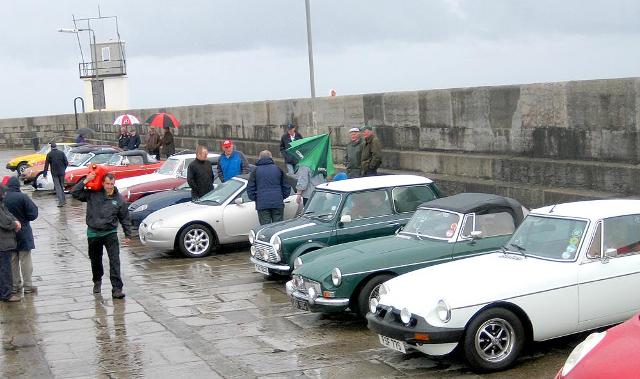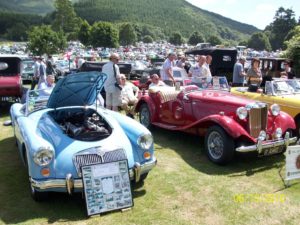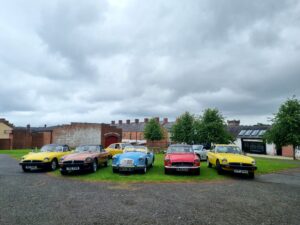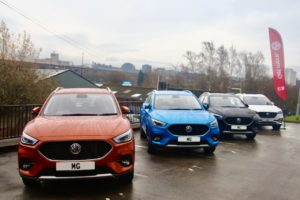An Australian MGA Odyssey
6 min read
Share this
The MG Owners’ Club (NI) attended a local Vintage Show in Ballygowan last September. There was plenty of chat as we had erected the club gazebo which acted as a focal point for members or others to gather, relax, enjoy a cup of coffee etc. and watch the ‘show’ go by. I got talking to a club member David McMullan.
David started to tell me of his exploits when he and a childhood friend decided to take a trip to Australia in an MGA. This was back in 1958. The full story had been written into the MG Enthusiasts magazine back in January 2013 but after listening to David I thought other club members should hear the story from the ‘horses’ mouth. I persuaded David to come along to our club meeting night on the 26th January 2015 and we got him to relive his trip.
Normally attendance at club meeting nights would be around 12 to 15 members but this night we had over 50 including friends from other clubs. Colin Robson, a relatively new member, and myself, had put together a power point presentation which aided David in his walk down memory lane.
I have highlighted some the salient points of the trip below…
David was living and working in Northern Ireland in 1958 when a boyhood friend, Norman Tosh, came over for a visit. At the time David was working in the family’s civil engineering firm and Norman was a master mariner, but somehow they got talking about going to Australia. Back then, this was an absolutely booming place where you could have three jobs at the same time without any problem – the Australian attitude was that if you could do something, you got on and did it. It was a place of excitement; they were in their mid-20s and were in the mood for an adventure.
What happened then was that one of the shipping companies Norman had been sailing with offered him a free passage as a relief navigating officer, and said that David could have a cabin for a very nominal price. This was a cargo ship of course, not a cruise liner. Then Norman said to David: ‘Do you think the MG would make it?’ And that’s how the adventure really began.
Norman was referring to the MGA that David was running at the time. She was almost new, and was actually the first MGA in Northern Ireland.
Preparations to the MGA included:
- Spare wheel moved from the boot to the bonnet.
- Second spare wheel bought and mounted on a roof rack. (The MGA was a Roadster, but had a fibreglass hardtop made by a firm in Holland Mews in London).
- Dunlop winter tyres fitted to the spare and rear wheels.
- Snow chains to fit the winter tyres.
- 30 gallon fuel tank fitted into the boot (and taking up virtually all of the space), connected to the standard petrol tank. (In many places in the Far East petrol would be virtually unobtainable, while in places like the Nullabor desert in Australia you could drive 700 miles without encountering a village, let alone a petrol station.
- Extra leaf put into each of the back springs.
- The passenger seat was made with the backrest quickly removable so that it could be made into a bed for one with the addition of a Li-Lo inflatable mattress.
The route was plotted following advice from Garrow Fisher Tours of Kingston tourism and bus company. The route options would see them travelling through France, Switzerland and Italy, across to Yugoslavia and Bulgaria, through Turkey and Iran to Afghanistan and then Pakistan, onto India and cross on the boat to Australia.
On Monday 16th February 1959, the planning stopped and the adventure began.
They were going to set off from Greenock in Scotland, where Norman’s parents and David’s sister lived. The mileometer when they set off read 45,926, and leaving Greenock was their first real run with the car and trailer fully loaded. They reached Dover on Saturday 21 February. On the Sunday, they caught the night ferry to Dunkirk.
The journey then took them through various adventures and countries. When they got to Turkey, they quickly discovered just how cold and snowy it could be, especially in the mountains. Even before reaching Ankara they’d got bogged down in a snow drift and had to dig the car out. Finally, on Thursday 12 March they reached Bazorgan and the border with Iran.
On 21 March, they entered Pakistan at Zanazak.
Crossing into India on 26 March, they passed the Golden Temple at Amritsar. They reached the Taj Mahal at night and saw it in moonlight, then bedded down for a sleep so that they could see it in the morning by daylight.
On the road to Bangalore, they had considerable trouble with monkeys. Whenever they stopped to eat, they had to keep the trailer firmly closed or they would be in like a flash, looking for food.
Eventually they made it down to the port of Dhanushkodi, where they planned to cross on the ferry to Ceylon. The delays and obstruction they faced here were absolutely terrible, with everything possible being done to frustrate them into paying yet another back-hander.
But they had to struggle through because Ceylon was the main port for P&O, and they wanted to get a ship from there to Perth. This was to be a nine-day voyage, in some ways a bit of luxury for them, but perhaps ‘boring’ would be a better word. They had thought of driving more of the way, but had been refused a visa for Burma.
However, there was one benefit from getting to Ceylon as, while driving through Colombo, David happened to see an old school friend from Greenock called Roy heading the other way in his Austin A30! It turned out he was living in Colombo and working for the ship repairers, Walker and Co.
They spent a very pleasant few days with Roy and his wife Joyce and with Freddie Harper of the British Car Company, waiting for the ship to arrive. On Thursday 9 April they loaded the car and trailer onto the Orcades, boarded at 6.00pm and sailed for Freemantle in Australia at midnight.
Finally, on Monday 4 April 1960 they arrived in Sydney after 12,688 miles and 600 gallons of fuel, giving approximately 20mpg. Looking back, there were two reasons why they made it. One was the meticulous planning and preparation over a five-month period, and the other was the relationship between Norman and David. Despite the often arduous, trying and dangerous conditions, they never had a disagreement of any kind and they each had the reassurance that they could depend on one another, no matter what was thrown at them.
The brake application counter fitted by Ferodo in the UK before David and Norman set off for Australia recorded 34,349 stabs on the pedal.
After living and working in Australia for some months, David and Norman were joined by their fiancées, Patricia and June, and had a double wedding in the Church of Scotland in Melbourne. David had a 16ft caravan built (also pulled by the MGA) to live in at Deniliquin in the Riverina district of New South Wales. Norman purchased a TF, which also towed his caravan.
After a couple of years, due to illness of a relative, David was asked if he would return to the UK and rejoin the family construction company in Lisburn, Northern Ireland. Although David and Patricia shipped the caravan home with them on the P&O Himalaya, the MGA was sold in Australia, probably a cause for subsequent regret – although it has been replaced by another MGA in recent years. Norman made use of his marine expertise and took up the position of Harbour Master on Christmas Island, later returning to the UK and entering the offshore oil industry and settling in Reigate, Surrey.
If you are interested in the full story take a look at the January 2013 edition of the MG Enthusiasts magazine or the January 2015 MGOC (NI) newsletter.






